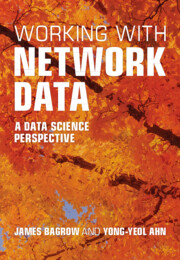Book contents
- Frontmatter
- Contents
- Preface
- Part I Background
- Part II Applications, tools, and tasks
- Interlude — Good practices for scientific computing
- Part III Fundamentals
- Chapter 21 Networks demand network thinking: the friendship paradox
- Chapter 22 Network models
- Chapter 23 Statistical models and inference
- Chapter 24 Uncertainty quantification and error analysis
- Chapter 25 Ghost in the matrix: spectral methods for networks
- Chapter 26 Embedding and machine learning
- Chapter 27 Big data and scalability
- Conclusion
- Bibliography
- Index
Chapter 22 - Network models
from Part III - Fundamentals
Published online by Cambridge University Press: 06 June 2024
- Frontmatter
- Contents
- Preface
- Part I Background
- Part II Applications, tools, and tasks
- Interlude — Good practices for scientific computing
- Part III Fundamentals
- Chapter 21 Networks demand network thinking: the friendship paradox
- Chapter 22 Network models
- Chapter 23 Statistical models and inference
- Chapter 24 Uncertainty quantification and error analysis
- Chapter 25 Ghost in the matrix: spectral methods for networks
- Chapter 26 Embedding and machine learning
- Chapter 27 Big data and scalability
- Conclusion
- Bibliography
- Index
Summary
Networks exhibit many common patterns. What causes them? Why are they present? Are they universal across all networks or only certain kinds of networks? One way to address these questions is with models. In this chapter, we explore in-depth the classic mechanistic models of network science. Random graph models underpin much of our understanding of network phenomena, from the small world path lengths to heterogeneous degree distributions and clustering. Mathematical tools help us understand what mechanisms or minimal ingredients may explain such phenomena, from basic heuristic treatments to combinatorial tools such as generating functions.
Keywords
- Type
- Chapter
- Information
- Working with Network DataA Data Science Perspective, pp. 327 - 350Publisher: Cambridge University PressPrint publication year: 2024

